6 books about Clunas, Craig
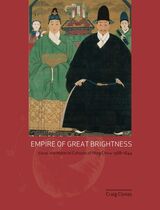
Empire of Great Brightness
Visual and Material Cultures of Ming China, 1368-1644
Craig Clunas
Reaktion Books, 2007
Empire of Great Brightness is an innovative and accessible history of a high point in Chinese culture as explored through the riches of its images and objects. Emphasizing the vibrant interactions between China and the rest of Asia at this period, it challenges notions of Ming China as a culture closed off from the rest of the world. Eminent historian Craig Clunas uses a wide range of pictures and objects from Ming China to illustrate areas such as painting and ceramics. He also draws on items like weapons and textiles from public and private collections, as well as contemporary sources from government edicts to novels, to illuminate this most diverse period of Chinese art and culture. Empire of Great Brightness offers a varied and stimulating resource for scholars of China’s cultural history, historians and art historians of related aspects of the early modern world, and readers who are intrigued by China’s past.
“An excellent companion for the study of Ming art, as well as giving established scholars food for thought and engaging in Ming Chinese culture.”—Art Newspaper
“This is an eminently readable history of the high point of Chinese cultures, seen through the riches of its images and objects.”—Asian Art Survey
[more]

Fruitful Sites
Garden Culture in Ming Dynasty China
Craig Clunas
Duke University Press, 1996
Gardens are sites that can be at one and the same time admired works of art and valuable pieces of real estate. As the first account in English to be wholly based on contemporary Chinese sources, this innovative, beautifully illustrated book grounds the practices of garden-making in Ming dynasty China (1368–1644) firmly in the social and cultural history of the day.
Who owned Ming gardens? Who visited them? How were they represented in words, in paintings, and in visual culture generally, and what meanings did these representations hold at different levels of Chinese society? How did the discourse of gardens intersect with other discourses such as those of aesthetics, agronomy, geomancy, and botany? By examining the gardens of the city of Suzhou from a number of different angles, Craig Clunas provides a rich picture of a complex cultural phenomenon—one that was of crucial importance to the self-fashioning of the Ming elite.
Drawing on a wide range of recent work in cultural theory, the author provides for the first time a historical and materialist account of Chinese garden culture, and replaces broad generalizations and orientalist fantasy with a convincing picture of the garden’s role in social life. Fruitful Sites will appeal to all students of China’s cultural history, to students of garden history from any part of the world, to art historians, and to readers engaged in Asian and cultural studies.
Who owned Ming gardens? Who visited them? How were they represented in words, in paintings, and in visual culture generally, and what meanings did these representations hold at different levels of Chinese society? How did the discourse of gardens intersect with other discourses such as those of aesthetics, agronomy, geomancy, and botany? By examining the gardens of the city of Suzhou from a number of different angles, Craig Clunas provides a rich picture of a complex cultural phenomenon—one that was of crucial importance to the self-fashioning of the Ming elite.
Drawing on a wide range of recent work in cultural theory, the author provides for the first time a historical and materialist account of Chinese garden culture, and replaces broad generalizations and orientalist fantasy with a convincing picture of the garden’s role in social life. Fruitful Sites will appeal to all students of China’s cultural history, to students of garden history from any part of the world, to art historians, and to readers engaged in Asian and cultural studies.
[more]
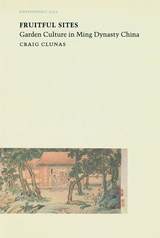
Fruitful Sites
Garden Culture in Ming Dynasty China
Craig Clunas
Reaktion Books, 1996
Gardens are sites that can be at one and the same time admired works of art and valuable pieces of real estate. As the first account in English to be wholly based on contemporary Chinese sources, this beautifully illustrated book grounds the practices of garden-making in Ming Dynasty China (1369–1644) firmly in the social and cultural history of the day.
Who owned gardens? Who visited them? How were they represented in words, in paintings and in visual culture generally, and what meanings did these representations hold at different levels of Chinese society? Drawing on a wide range of recent work in cultural theory, Craig Clunas provides for the first time a historical and materialist account of Chinese garden culture, and replaces broad generalizations and orientalist fantasy with a convincing picture of the garden's role in social life.
Who owned gardens? Who visited them? How were they represented in words, in paintings and in visual culture generally, and what meanings did these representations hold at different levels of Chinese society? Drawing on a wide range of recent work in cultural theory, Craig Clunas provides for the first time a historical and materialist account of Chinese garden culture, and replaces broad generalizations and orientalist fantasy with a convincing picture of the garden's role in social life.
[more]
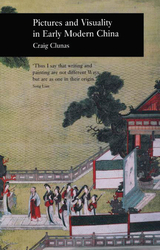
Pictures and Visuality in Early Modern China
Craig Clunas
Reaktion Books, 2005
Pictures and Visuality in Early Modern China is not simply a survey of sixteenth-century images, but rather, a thorough and thoughtful examination of visual culture in China's Ming Dynasty, one that considers images wherever they appeared—not only paintings, but also illustrated books, maps, ceramic bowls, lacquered boxes, painted fans, and even clothing and tomb pictures.
Clunas's theory of visuality incorporates not only the image and the object upon which it is placed but also the culture which produced and purchased it. Economic changes in sixteenth-century China—the rapid expansion of trade routes and a growing class of consumers—are thus intricately bound up with the evolution of the image itself. Pictures and Visuality in Early Modern China will be a touchstone for students of Chinese history, art, and culture.
Clunas's theory of visuality incorporates not only the image and the object upon which it is placed but also the culture which produced and purchased it. Economic changes in sixteenth-century China—the rapid expansion of trade routes and a growing class of consumers—are thus intricately bound up with the evolution of the image itself. Pictures and Visuality in Early Modern China will be a touchstone for students of Chinese history, art, and culture.
[more]
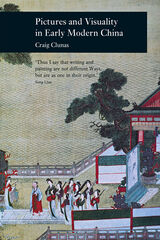
Pictures and Visuality in Early Modern China
Craig Clunas
Reaktion Books, 2005
Pictures and Visuality in Early Modern China is not simply a survey of sixteenth-century images, but rather, a thorough and thoughtful examination of visual culture in China's Ming Dynasty, one that considers images wherever they appeared—not only paintings, but also illustrated books, maps, ceramic bowls, lacquered boxes, painted fans, and even clothing and tomb pictures.
Clunas's theory of visuality incorporates not only the image and the object upon which it is placed but also the culture which produced and purchased it. Economic changes in sixteenth-century China—the rapid expansion of trade routes and a growing class of consumers—are thus intricately bound up with the evolution of the image itself. Pictures and Visuality in Early Modern China will be a touchstone for students of Chinese history, art, and culture.
Clunas's theory of visuality incorporates not only the image and the object upon which it is placed but also the culture which produced and purchased it. Economic changes in sixteenth-century China—the rapid expansion of trade routes and a growing class of consumers—are thus intricately bound up with the evolution of the image itself. Pictures and Visuality in Early Modern China will be a touchstone for students of Chinese history, art, and culture.
[more]
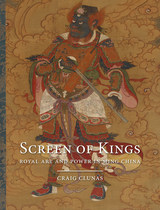
Screen of Kings
Royal Art and Power in Ming China
Craig Clunas
Reaktion Books, 2013
Screen of Kings is the first book in any language to examine the cultural role of the regional aristocracy – relatives of the emperors – in Ming dynasty China (1368–1644). Through an analysis of their patronage of architecture, calligraphy, painting and other art forms, and through a study of the contents of their splendid and recently-excavated tombs, this innovative study puts the aristocracy back at the heart of accounts of China’s culture, from which they have been excluded until very recently.
Screen of Kings challenges much of the received wisdom about Ming China. Craig Clunas sheds new light on many familiar artworks, as well as work that have never before been reproduced. New archaeological discoveries have furnished the author with evidence of the lavish and spectacular lifestyles of these provincial princes and demonstrate how central the imperial family was to the high culture of the Ming era.
Written by the leading specialist in the art and culture of the Ming period, this book will illuminate a key aspect of China’s past, and will significantly alter our understanding of the Ming. It will be enjoyed by anyone with a serious interest in the history and art of this great civilization.
[more]
READERS
Browse our collection.
PUBLISHERS
See BiblioVault's publisher services.
STUDENT SERVICES
Files for college accessibility offices.
UChicago Accessibility Resources
home | accessibility | search | about | contact us
BiblioVault ® 2001 - 2024
The University of Chicago Press









